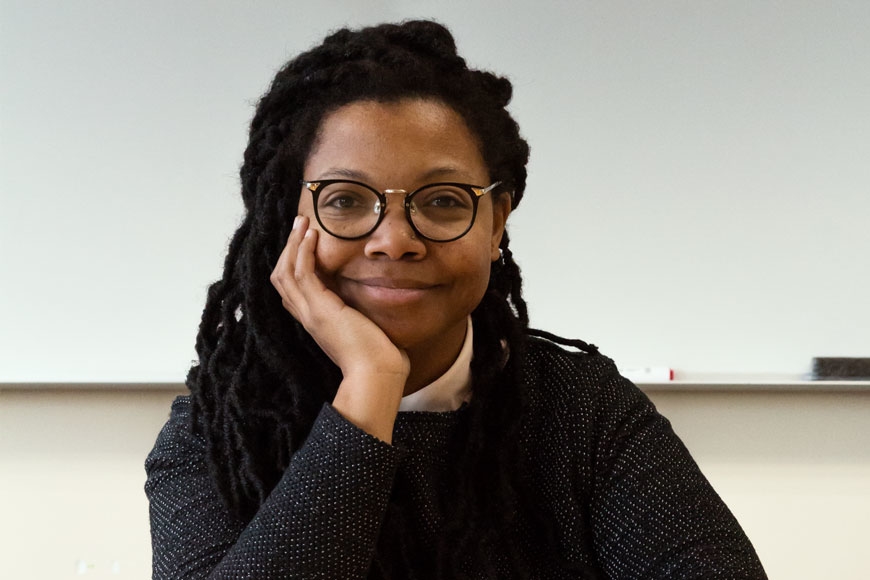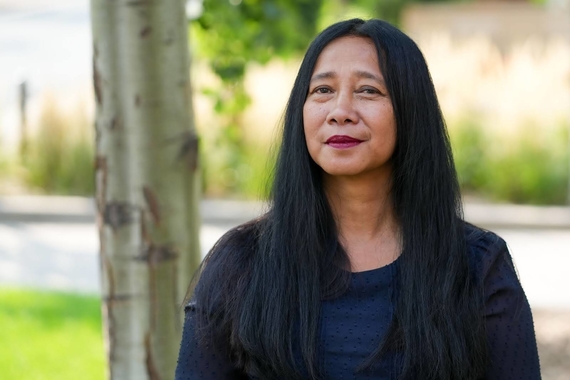When Housing Isn’t for All: Working Toward More Inclusive Housing Strategies
If you were on the East Bank during spring 2017, you may have seen doctoral candidate Tia-Simone Gardner creating a small structure in the project test site known as “the sandbox” behind Rapson Hall. You might have assumed she was an architecture student working on a prototype, but in fact she was working on her dissertation for her degree from the Department of Gender, Women & Sexuality Studies.
Gardner’s project—creating a 208-square-foot structure—and subsequent research was developed with the intersectionality, or overlapping of social categorizations, of Black feminism, architecture, and geography in mind. Her research looks at the relationship between large cities and small housing spaces, specifically looking at how cities can use under- and un-utilized spaces as affordable or temporary housing projects.
Tiny Spaces
The first step was to build her “mobile artist residency” (what others may recognize as a “tiny house”) with her own two hands and much assistance from her friends and Tiny House Builder Robin Hayes. Gardner then began requesting land from city governments and housing associations around the Twin Cities to experience first-hand how affordable housing—and more specifically, development—works.
Approaching city planners with a viable housing request allowed her to gain more accurate insight into the process than she could have gotten with a theoretical request. In the latter case, city officials might have been overly optimistic about the likelihood of granting her request. Having a tangible unit prevented them from pretending there is no stigma about small-scale mobile housing.
Going through that process gave her an alternative perspective on urban planning. “I decided to do it this way because it let me see the city from the inside-out, instead of approaching it from the outside-in, where I would go and interview a city planner about a theoretical thing,” says Gardner.
It wasn’t easy. Gardner asserts that many city housing regulations aim to make smaller, affordable housing properties like hers less feasible. The reason she cites is that affordable housing is attached to the image of “a certain type of person who needs affordable housing”—whom many cities may prefer to be elsewhere.
She has concluded that Minneapolis was designed and planned with nuclear families in mind, benefitting members of certain family structures and economic backgrounds. This is seen in protocols like building codes, such as a mandate that newly-built houses have a garage—something that would not make sense for all residents. Requiring a garage assumes that a resident owns a car—despite being in a city with a robust public transportation system. Car ownership implies a higher socioeconomic level, which connects to issues of race and class.
“There’s a reason that tiny houses aren’t called mobile homes when that is exactly what they are,” Gardner says, noting that the phrase “mobile home” has a perceived negative connotation attached to it. She hopes that her work will help make small, mobile housing seem like a feasible housing option for people who couldn’t otherwise see themselves choosing a small house, even as a temporary housing strategy.
Following Intuition
Black feminisms and race and gender studies have always interested Gardener. Her interest in these fields grew while studying art and art history at the University of Alabama–Birmingham. She would go on to get her MFA from University of Pennsylvania, where she began working with interdisciplinary practices, photography, and videography.
In 2009 Gardner participated in the Whitney Independent Study Program, an extremely selective program within Manhattan’s Whitney Museum of American Art. There, her intertwining interests in feminist studies and art flourished in the program’s community of artists, curators, and art-historian-philosophers. By examining works on critical theory and cultural studies, she learned a new approach to absorbing information. “There wasn’t much that I couldn’t understand—it was just a matter of unpacking it,” Gardner says.
She notes how different fields of study require different approaches to absorbing information. Whereas fields like anthropology or sociology often study “humanness” from much earlier in the human record, Gardner believes that “feminism has always been critical of humanness and starts out from the position of seeing it as already gendered, raced, and connected to citizenship or colonization.” Since gender studies is an interdisciplinary field, she had the freedom to do what she wanted with it and continued learning about the areas she is passionate about. Wanting to go deeper, she followed her intuition to the University of Minnesota to earn her PhD in gender, women & sexuality studies.
She chose the University of Minnesota for its outstanding women’s studies programs. She also appreciates living in one of the most supportive states in terms of public funding of the arts.
An Artist and a Scholar
Gardner is both an artist and a scholar, a somewhat complicated fusion she often finds herself contemplating. Her two worlds are generally assumed to be separate—colleagues in either realm don’t always realize that both are prominent parts of her life.
In her experience, there are several differences between scholars and artists; the first being the amount of time spent on a project. Artists, she says, often pick up projects and set them down—starting and stopping when it feels right. That’s not exactly how academic research goes. The second difference she sees is idea of completion and understanding. “With art, you're sort of okay with not knowing the whole—you're just not going to know the whole. And someone else can fill in the gaps later." The third is that artists often have multiple projects going on at once, which can add to projects being set down and later picked back up. When she arrived at the University five years ago, she focused mainly on academia and stopped creating art for nearly three years—something she realized she needed back in her life.
Her tiny house provided the opportunity for her two worlds to overlap. Gardner combined her artistic ability and eye for design with her academic expertise to design visually appealing tiny houses that are just as functional. Having opportunities to utilize being a scholar and an artist can result in captivating, cross-disciplinary work.
Reading the River Yemaya and Oshún
One of the projects that Gardner worked on but had to put down was a work that looked at the cities along the Mississippi River that housed former slave ports. This was a way to connect what felt, at the time, a wide gulf between the southeastern United States, where Gardner is originally from, and the midwest, where she currently lives. Gardner is developing this project this spring while in residence in New Orleans at A Studio in the Woods, a program of Tulane University. She will focus on gathering film, using surveillance cameras, photographs, and texts, which she will collaboratively write with other Black women artists and geographers in New Orleans.
This story was written by an undergraduate student account executive in CLAgency. Meet the team.



